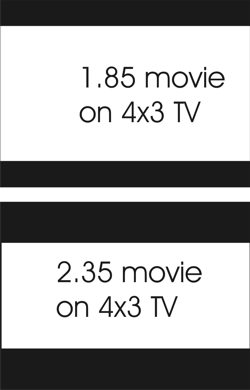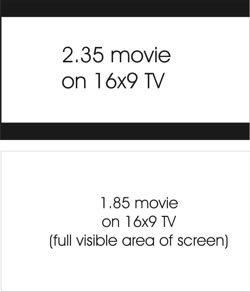 The Skinny on Wide Screens
The Skinny on Wide Screens
By Jim Bray
Now that the industry is moving toward widescreen TV’s, you may be wondering
about 16x9 TV's versus the 4x3 aspect ratio you've known since childhood.
These questions can include: “What do ‘letterboxed,’ ‘anamorphic’ and ‘enhanced
for 16x9 TV’s’ mean?” “Is widescreen better than ‘Full
Screen’?” “What are those black bars?” “What
are those gray bars?” You may even hear “Why does my DVD player
make everyone look so thin?”
These are all good questions, the answers for which can help you get the most
enjoyment from your TV investment.
If you know the answers….
"Thin Screen" TV….
Old style TV and movies feature an almost square 4x3 (1.33:1) aspect ratio.
That made putting movies onto TV in the “old days” easy, because
there was no question of “reformatting the program to fit your TV,” to
paraphrase the disclaimer often shown when movies are shown on TV.
But in the 1950’s, movies tried to “broaden” their appeal
by going widescreen, offering moviegoers an experience they couldn’t
get at home. They tried a few other things too, like 3D (which may be experiencing
a comeback), but widescreen has lasted without pause.
Movies today generally come in two widescreen aspect ratios: Standard (1.85:1)
and “Scope” (2.35:1), with occasional variations like 1.66:1 (some
older movies and animated features), 2.40:1 and 2.76:1 (epics like Ben-Hur).
And now that television’s going wide, an increasing number of programs
are being shot wide, in what’s called 1.78:1 (or 16x9) – which
just happens to be the shape of those widescreen TV’s that are pushing
the old style sets off of store shelves.
1.78:1 and 1.85:1 aspect ratios both fill the widescreen TV from top to bottom
and side to side, which shouldn’t really be. In practical terms, however,
they’re identical to most viewers and this is the most enjoyable aspect
ratio on a widescreen TV because it uses all the real estate. The “ultra
wide” movies still leave black bars above and below the picture on the
screen, though they’re much smaller and less noticeable than letterboxing
is on a 4x3 TV.
Which brings us to letterboxing and Pan&Scan. It's impossible to get widescreen
movies onto a “square screen” TV without altering the picture somehow
to fit the TV. This led to Pan&Scan videos (and movies broadcast on TV),
where engineers try to follow the action on the wide frame by panning across
the action as it’s recorded (I’m oversimplifying, of course, but
you get the idea). This not only leads to a part of the original image being
sliced off, it can add artificial “camera movements” to a program
that aren’t what the director intended and that can be really intrusive
if sloppily done.
Unfortunately, this is usually referred to as “Full Screen,” which
is misleading because, while it does fill the screen, it’s at the expense
of the original panoramic widescreen image and can really ruin the movie.
Laserdiscs, and some VHS, got around this by “Letterboxing,” which
shows the entire image from side to side. But since the widescreen frame is
shaped differently than the “full screen” TV, this left unused
areas above and below the image – those infamous blank black bars.
 Stretching things….
Stretching things….
Even these so-called “widescreen” laserdiscs were manufactured
in the standard 4x3 aspect ratio of the video technology of their day. DVD’s,
however, were born when the transition to 16x9 TV’s was already planned,
and the designers of the technology chose, wisely, to make the format compatible
with the new aspect ratio. This opened up the opportunity to allow for truly
widescreen pictures on widescreen TV’s.
These are the “anamorphic” or “enhanced for widescreen TV’s” DVD’s – and
they’re the best of all worlds. They’re created by either transferring
a widescreen film to video from a print where the actual film frame appears
squeezed horizontally (an anamorphic print), or by squeezing it electronically
after transfer.
When your DVD player is set to output at 16x9, anamorphic images are expanded
to fill the 16x9 TV screen from side to side - and they can look splendid.
For 4x3 TV’s, DVD players unsqueeze the picture electronically, drop
some of the horizontal resolution, and letterbox the picture. It isn't as good,
but it works if you haven't moved to a widescreen TV yet – and will work
even better when you do (and switch the output setting of your DVD player).
Be careful of your settings, though: if your DVD player is set to output 16x9
but is connected to a 4x3 TV, everything will look tall and thin. I like to
call it "Super model Syndrome." Likewise, if your TV is 16x9
and your DVD player's set to 4x3, everything will look short and dumpy. You
can refer to it as "Jim Bray Syndrome."
“Letterboxed” titles aren’t anamorphic, so you should pay
attention to the labeling on the DVD's box before you buy a disc. While most
widescreen DVD's are truly enhanced for 16x9 TV's, some are still merely letterboxed
and, on a 16x9 TV, letterboxing only outputs a “widescreen” image
to the center section of the screen, with black bars above and below and to
each side, surrounding the picture with a sea of black.
You can usually zoom these pictures to fill the 16x9 screen, but with a noticeable
loss of resolution that can make it look as if you're watching through a screen
door. It’s acceptable if there’s no anamorphic version available,
but it pales in comparison to a real widescreen picture.
Those bars beside the picture also appear with “regular” (traditional)
TV or “full screen” videos shown on a 16x9 TV. And they can burn
in if you watch too much stuff that way, except on LCD TV’s, so make
sure you use one of the zoom settings on your 16x9 TV to prevent ruining your
investment over time.
So if you're looking to buy a TV and some DVD's today, here’s the bottom
line pitch: go wide with the TV, go anamorphic with the DVD's, and you'll go
to video heaven!